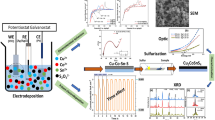Abstract
Deposition of charged particles under an electrical field which is expressed as the electrophoretic deposition (EPD) is a fast and simple method of nanoparticle coating. In this research, a comprehensive study was performed to improve the TiO2 film properties by application of modulated electrical fields with different amplitudes, waveforms, and frequencies. The suspension parameters (solvent composition, electrical conductivity, and additive concentration) were also optimized. Final photo-electrodes were characterized with scanning electron microscopy (SEM), atomic force microscopy (AFM), physicochemical, polarization, and photo-electrochemical studies. Based on the results, less particle consumption with better substrate coverage was obtained by applying modulated electrical fields. In the I-V test, the photo-electrodes constructed by applying AC signals with the square waveform at 100 Hz and sinusoidal waveform at 1 kHz showed photo-current density enhancement of about 21 and 18 times (in 1 V vs. Ag/AgCl), respectively, and about 40 % less deposited particle mass in comparison to the photo-electrode prepared in conventional DC electrical field. AC electrical fields could also be used with suspensions containing water as the green solvent. All observations in the EPD processing were successfully interpreted with an electrochemical circuit model that was developed based on the electrochemical impedance spectroscopy (EIS) results and analysis of deposition current.

ᅟ








Similar content being viewed by others
References
Tsakalakos L (2010) Nanotechnology for photovoltaics. In: Nanotechnol. Photovoltaics. CRC Press, pp 1–48
Nomura K, Ohta H, Takagi A, et al. (2004) Nature 432:488–492
Minami T (2005) Semicond Sci Technol 20:S35–S44
Nomura K, Takagi A, Kamiya T, et al. (2006) Jpn J Appl Phys 45:4303–4308
Youngblood WJ, Lee S-HA, Maeda K, Mallouk TE (2009) Acc Chem Res 42:1966–1973
Chan SHS, Yeong Wu T, Juan JC, Teh CY (2011) J Chem Technol Biotechnol 86:1130–1158
Kavan L (2012) Chem Rec 12:131–142
Grätzel M (2001) Nature 414:338–344
Regonini D, Teloeken AC, Alves AK, et al. (2013) ACS Appl Mater Interfaces 5:11747–11755
Quan X, Yang S, Ruan X, Zhao H (2005) Environ Sci Technol 39:3770–3775
Qin D-D, Bi Y-P, Feng X-J, et al. (2015) Chem Mater 27:4180–4183
Hwang YJ, Hahn C, Liu B, Yang P (2012) ACS Nano 6:5060–5069
Hagfeldt A, Boschloo G, Sun L, et al. (2010) Chem Rev 110:6595–6663
Corni I, Ryan MP, Boccaccini AR (2008) J Eur Ceram Soc 28:1353–1367
Laxmidhar B, Liu M (2007) Prog Mater Sci 52:1–61
Ferrari B, Moreno R (2010) J Eur Ceram Soc 30:1069–1078
Brown DR, Salt FW (1965) J Appl Chem 15:40–48
Sarkar P, Nicholson PS, Sarkar PNP (1996) J Am Ceram Soc 79:1987–2002
Van der Biest OO, Vandeperre LJ (1999) Annu Rev Mater Sci 29:327–352
Ammam M (2012) RSC Adv 2:7633–7646
Chávez-Valdez A, Boccaccini AR (2012) Electrochim Acta 65:70–89
Kawakita M, Uchikoshi T, Kawakita J, Sakka Y (2009) J Am Ceram Soc 92:984–989
Uchikoshi T, Suzuki TS, Tang F, et al. (2004) Ceram Int 30:1975–1978
Pascall AJ, Qian F, Wang G, et al. (2014) Adv Mater 26:2252–2256
Singh A, English NJ, Ryan KM (2013) J Phys Chem B 117:1608–1615
Chávez-Valdez A, Herrmann M, Boccaccini AR (2012) J Colloid Interface Sci 375:102–105
Pettibone JM, Cwiertny DM, Scherer M, Grassian VH (2008) Langmuir 24:6659–6667
Jassby D, Farner Budarz J, Wiesner M (2012) Environ Sci Technol 46:6934–6941
Yum J-HH, Kim S-SS, Kim D-YY, Sung Y-EE (2005) J Photochem Photobiol A Chem 173:1–6
Van Tassel JJ, Randall CA (2006) J Mater Sci 41:8031–8046
Dor S, Rühle S, Ofir A, et al. (2009) Colloids Surf A Physicochem Eng Asp 342:70–75
Jouyban A, Soltanpour S, Chan HK (2004) Int J Pharm 269:353–360
Kijitori Y, Ikegami M, Miyasaka T (2007) Chem Lett 36:190–191
Popa AM, Vleugels J, Vermant J, Van der Biest O (2006) J Eur Ceram Soc 26:933–939
Tang F, Uchikoshi T, Ozawa K, Sakka Y (2006) J Eur Ceram Soc 26:1555–1560
Umegaki T, Yan JM, Zhang XB, et al. (2009) Int J Hydrog Energy 34:3816–3822
Hirai H, Chawanya H, Toshima N (1985) React Polym Ion Exch Sorbents 3:127–141
Chen H-WW, Huang K-CC, Hsu C-YY, et al. (2010) Electrochim Acta 56:7991–7998
Eaton P, West P (2010) Atomic force microscopy. Oxford Univ Press
Nečas D, Klapetek P (2012) Open Phys 10:181–188
Bard AJ, Faulkner LR (1944) Electrochemical methods fundamentals and applications. John Wiley, New York
Reynal A, Palomares E (2011) Eur J Inorg Chem 2011:4509–4526
Rashin A (1990) J Phys Chem 94:1725–1733
Farrokhi-Rad M, Shahrabi T (2012) J Am Ceram Soc 95:3434–3440
Acknowledgments
The authors acknowledge the Iran National Science Foundation, Isfahan University of Technology Research Council (IUT), Isfahan Regional Electrical Company, and Center of Excellency in Sensor and Green Chemistry of IUT for supporting this work.
Author information
Authors and Affiliations
Corresponding author
Electronic supplementary material
ESM 1
(DOCX 1992 kb)
Rights and permissions
About this article
Cite this article
Rezaei, B., Taki, M. & Ensafi, A.A. Modulated electrical field as a new pulse method to make TiO2 film for high- performance photo-electrochemical cells and modeling of the deposition process. J Solid State Electrochem 21, 371–381 (2017). https://doi.org/10.1007/s10008-016-3363-8
Received:
Revised:
Accepted:
Published:
Issue Date:
DOI: https://doi.org/10.1007/s10008-016-3363-8




